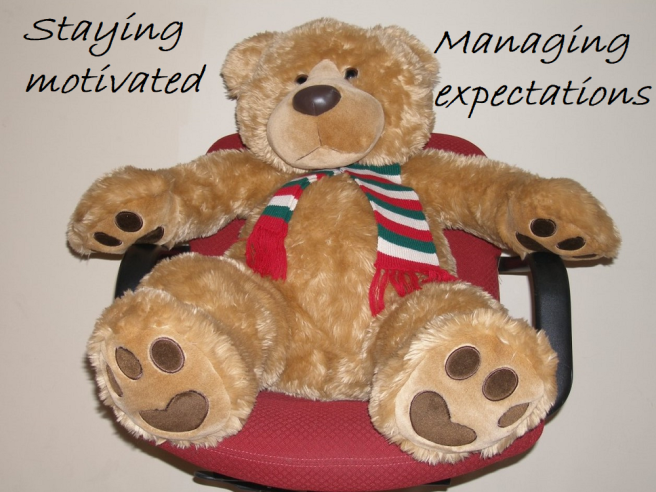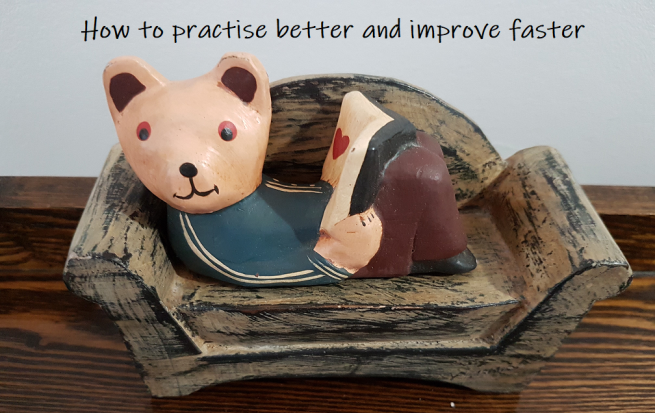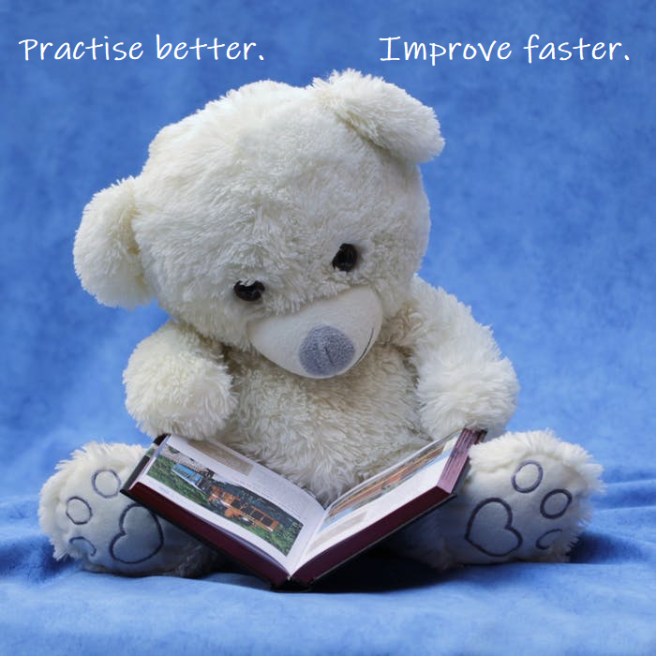 For the last two weeks, I’ve talked about how practising in a different way, in small manageable chunks with complete attention, totally absorbed in the task at hand, can bring about improvement more quickly. It’s much more effective to practise for shorter periods before the muscles start to weaken and the mind starts to wander.
For the last two weeks, I’ve talked about how practising in a different way, in small manageable chunks with complete attention, totally absorbed in the task at hand, can bring about improvement more quickly. It’s much more effective to practise for shorter periods before the muscles start to weaken and the mind starts to wander.
Still, there’s what I call the “frustration” factor. You’re working with full concentration and practising every day, but in your own mind, change seems to be taking forever.
How do you stay motivated? How do you keep going? How do you not give up?
The first thing, of course, is to have a very clear long-term goal in mind. Is it:
- to get through conversations without being asked to repeat yourself?
- to get that promotion that has been held back because of your communication skills?
- to communicate more effectively with colleagues, clients, customers, patients?
- to make yourself understood on the telephone?
- to speak more like your kids?
Having your long-term goal clearly in mind is very important. Equally important is having reasonable expectations: understanding that learning takes place in five stages and recognizing and embracing each stage as it arrives.
Stage 1
When you first begin the study of accent management, expect that you’ll leave class and forget everything you’ve learned. Why should you remember anything? You’re letting go of habits you’ve held from the time you started learning this new language – quite possibly years! You’re going to refocus your brain, reprogram your ears, retrain your muscles and strengthen your memory. So just congratulate yourself on having had the courage to actually begin a program of study.
Stage 2
Very soon you begin to develop awareness. You start noticing sounds that you’d never heard before. Certain patterns begin to emerge. You hear syllable stress. This is very exciting. Embrace it, but don’t get too excited. Just keep practising exactly as you have been, in manageable little chunks with full attention, every day. Keep listening passively and absorb what you hear. The filter between your native language and English is beginning to dissipate.
Stage 3
You start noticing your mistakes. You may get frustrated, even angry with yourself. You just can’t seem to make the changes you need to match the sounds and rhythms you’re hearing all around you. That’s okay. Your mind is making the connections. You’re on the verge of change! Keep practising in small manageable chunks, with full attention.
Stage 4
It happens at last! Your awareness shifts. Your muscles get into the correct positions to create the sounds you’ve been hearing. You’re remembering where to put the syllable stress, the word stress. You begin experimenting with the short-form English you’ve been hearing but were afraid to use: gotta, hafta, doncha, wanna. You start, tentatively, linking one syllable to the next.
Stage 5
Now your speech begins to flow as your muscles get stronger and move more quickly. You incorporate more of the English vernacular. You drop consonants, change vowels, add words and expressions in a way you had never thought you would.
These are the stages of learning, and they arrive with continuous concerted focused practice. There are bumps along the way, for sure. At times you may feel stuck.
But like a baby, you’ve been taking small steps, falling down and getting back up, listening to the world around you with innocence and wonder until you start to take note, understand, imitate and make things your own. So keep your long-term goal in mind, but be supportive of your growth.
Be patient. Be determined. And above all, don’t give up.

 In last week’s post
In last week’s post 
 I was always aware of the question of “identity” in accent modification, but it didn’t really hit me in the face until, as I mentioned in last week’s post
I was always aware of the question of “identity” in accent modification, but it didn’t really hit me in the face until, as I mentioned in last week’s post  The other day there was a client in one of my group classes who made the most interesting observation. This person was, as are most of my clients, a very advanced speaker of ESL. She had been in English-speaking countries for the last ten years and was picking up the sounds of vowels and consonants very quickly. But finding the “music” of English was particularly challenging: the idea of linking consonants and vowels from syllable to syllable to find a flowing rhythm, and changing pitch to find melodies that express meaning more readily. There was also some resistance to what I call “short-form” English, the spoken expressions that we native English speakers use all the time but which have almost nothing to do with written English (e.g., wanna, gonna, gotta, hafta).
The other day there was a client in one of my group classes who made the most interesting observation. This person was, as are most of my clients, a very advanced speaker of ESL. She had been in English-speaking countries for the last ten years and was picking up the sounds of vowels and consonants very quickly. But finding the “music” of English was particularly challenging: the idea of linking consonants and vowels from syllable to syllable to find a flowing rhythm, and changing pitch to find melodies that express meaning more readily. There was also some resistance to what I call “short-form” English, the spoken expressions that we native English speakers use all the time but which have almost nothing to do with written English (e.g., wanna, gonna, gotta, hafta).